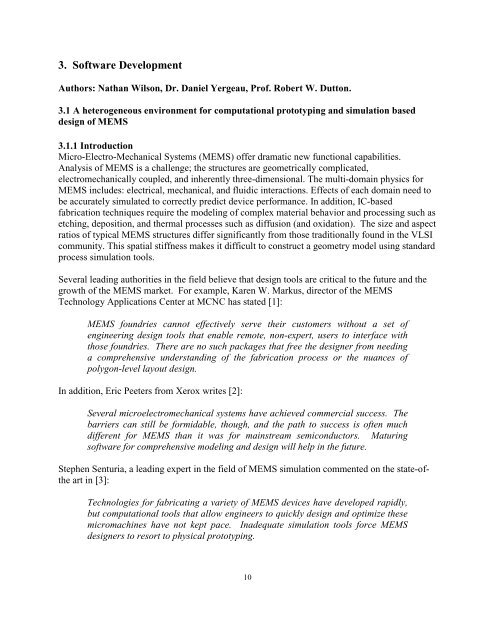Advanced CAD System for Electromagnetic MEMS Interactive Analysis
Advanced CAD System for Electromagnetic MEMS Interactive Analysis
Advanced CAD System for Electromagnetic MEMS Interactive Analysis
You also want an ePaper? Increase the reach of your titles
YUMPU automatically turns print PDFs into web optimized ePapers that Google loves.
3. Software Development<br />
Authors: Nathan Wilson, Dr. Daniel Yergeau, Prof. Robert W. Dutton.<br />
3.1 A heterogeneous environment <strong>for</strong> computational prototyping and simulation based<br />
design of <strong>MEMS</strong><br />
3.1.1 Introduction<br />
Micro-Electro-Mechanical <strong>System</strong>s (<strong>MEMS</strong>) offer dramatic new functional capabilities.<br />
<strong>Analysis</strong> of <strong>MEMS</strong> is a challenge; the structures are geometrically complicated,<br />
electromechanically coupled, and inherently three-dimensional. The multi-domain physics <strong>for</strong><br />
<strong>MEMS</strong> includes: electrical, mechanical, and fluidic interactions. Effects of each domain need to<br />
be accurately simulated to correctly predict device per<strong>for</strong>mance. In addition, IC-based<br />
fabrication techniques require the modeling of complex material behavior and processing such as<br />
etching, deposition, and thermal processes such as diffusion (and oxidation). The size and aspect<br />
ratios of typical <strong>MEMS</strong> structures differ significantly from those traditionally found in the VLSI<br />
community. This spatial stiffness makes it difficult to construct a geometry model using standard<br />
process simulation tools.<br />
Several leading authorities in the field believe that design tools are critical to the future and the<br />
growth of the <strong>MEMS</strong> market. For example, Karen W. Markus, director of the <strong>MEMS</strong><br />
Technology Applications Center at MCNC has stated [1]:<br />
<strong>MEMS</strong> foundries cannot effectively serve their customers without a set of<br />
engineering design tools that enable remote, non-expert, users to interface with<br />
those foundries. There are no such packages that free the designer from needing<br />
a comprehensive understanding of the fabrication process or the nuances of<br />
polygon-level layout design.<br />
In addition, Eric Peeters from Xerox writes [2]:<br />
Several microelectromechanical systems have achieved commercial success. The<br />
barriers can still be <strong>for</strong>midable, though, and the path to success is often much<br />
different <strong>for</strong> <strong>MEMS</strong> than it was <strong>for</strong> mainstream semiconductors. Maturing<br />
software <strong>for</strong> comprehensive modeling and design will help in the future.<br />
Stephen Senturia, a leading expert in the field of <strong>MEMS</strong> simulation commented on the state-ofthe<br />
art in [3]:<br />
Technologies <strong>for</strong> fabricating a variety of <strong>MEMS</strong> devices have developed rapidly,<br />
but computational tools that allow engineers to quickly design and optimize these<br />
micromachines have not kept pace. Inadequate simulation tools <strong>for</strong>ce <strong>MEMS</strong><br />
designers to resort to physical prototyping.<br />
10
















